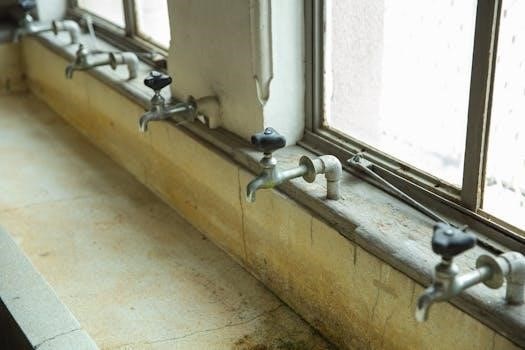
-
By:
- otis
- No comment
korky fill valve instructions
Korky Fill Valve⁚ An Overview
Korky fill valves are designed to address common toilet issues like slow filling‚ running‚ and noisy operation. These valves offer a universal design‚ fitting various brands and both one-piece and two-piece toilets. They are known for their ease of installation and adjustment‚ often requiring no tools.
Common Problems Addressed by Korky Fill Valves
Korky fill valves are engineered to tackle several frequent toilet malfunctions‚ notably slow or no refilling of the toilet tank after flushing‚ a frustrating issue that can lead to inconvenience. Another common problem is a constantly running toilet‚ which not only wastes water but also results in increased water bills; Korky valves address this by providing a reliable shut-off mechanism. Moreover‚ these valves aim to eliminate noisy toilets‚ a common annoyance caused by older or faulty fill valve components. These valves are designed to offer a more silent operation‚ thus reducing disruption in the household. They often involve a quick and simple fix‚ using a twist-lock adjustment for ease of installation. Korky valves are intended to be a comprehensive solution to these common toilet issues‚ improving the efficiency and functionality of your toilet.
Korky QuietFILL vs. Platinum QuietFILL
The Korky QuietFILL and Platinum QuietFILL valves both aim to provide quieter operation compared to standard fill valves‚ but they cater to different needs. The standard QuietFILL is a universal option designed for most toilets‚ offering adjustable features for various tank sizes and configurations. It’s ideal for general use‚ addressing common problems like slow filling and running toilets. On the other hand‚ the Platinum QuietFILL is specifically engineered for toilets manufactured since 1994‚ which typically use 1.6 gallons per flush or less. It includes a refill adjuster to deliver the precise amount of water to the bowl‚ maintaining optimal flushing performance and preventing water waste. While both share the easy‚ tool-free installation design‚ the Platinum version is more focused on water conservation and modern toilet specifications‚ making it a more advanced option for newer plumbing systems and water-saving initiatives.

Installation Process
Installing a Korky fill valve is designed to be straightforward‚ often requiring no special tools. The process involves removing the old valve‚ inserting the new one‚ and making necessary adjustments. Proper height setting and refill tube connection are crucial steps.
Tools Needed for Installation
The beauty of Korky fill valve installation lies in its simplicity‚ often requiring minimal tools. In many cases‚ you won’t need any tools at all‚ as the design is intended for a tool-free setup. However‚ having a few basic tools on hand can be beneficial. An adjustable wrench might be helpful for tightening the water supply line and the mounting nut‚ although hand-tightening is often sufficient. A pair of pliers can also be useful for gripping and manipulating small parts‚ especially when disconnecting the old fill valve. A small bucket or container is handy to catch any residual water when disconnecting the old valve. Additionally‚ a towel or sponge can help to clean up any spills or drips during the process. While not strictly necessary‚ having these tools available ensures a smoother and more efficient installation experience. It’s always good to be prepared‚ even for a task designed to be tool-free.
Step-by-Step Installation Guide
To begin‚ turn off the water supply to your toilet and flush to empty the tank. Disconnect the water supply line from the old fill valve. Then‚ remove the old fill valve by unscrewing the mounting nut underneath the tank. Place the new Korky fill valve into the tank‚ ensuring the refill tube is positioned towards the overflow tube. Secure the mounting nut by hand‚ bevel side up. Adjust the valve height‚ ensuring the CL mark is at the proper water level. Connect the refill tube to the overflow tube. Finally‚ reconnect the water supply line and slowly turn the water back on. Check for leaks and make any necessary adjustments. The innovative twist-lock mechanism of Korky fill valve simplifies height adjustments. Ensure the valve is locked in place by twisting clockwise. The valve will rise slightly when locking in place. Remember‚ hand-tightening is usually sufficient for the mounting nut‚ avoiding over-tightening.
Adjusting the Fill Valve Height
Adjusting the height of your Korky fill valve is crucial for proper toilet function‚ and it’s designed to be a straightforward process. First‚ locate the twist-lock mechanism on the valve. Hold the bottom of the valve firmly and twist the top part counterclockwise to unlock it. This will allow you to slide the valve up or down‚ adjusting its overall height. The key adjustment point is the “CL” mark on the valve; this mark should align with the desired water level in your toilet tank. Once you have set the height‚ twist the top of the valve clockwise to lock it into place. Ensure it’s secure and does not move. The valve height typically adjusts from 7 3/4 inches to 13 1/2 inches‚ fitting most toilet models. Remember that the valve will rise slightly upon locking. Proper height adjustment prevents water waste and ensures optimal flushing performance. Always check the water level after adjusting to confirm it fills correctly.
Connecting the Refill Tube
Connecting the refill tube correctly is essential for proper toilet operation after installing your Korky fill valve; The refill tube’s purpose is to replenish water in the toilet bowl after each flush‚ maintaining the correct water level for optimal performance. Begin by locating the small port on the fill valve where the refill tube attaches. Next‚ find the overflow tube within your toilet tank. This is a vertical tube‚ usually located near the center of the tank. The refill tube should be attached securely to the port on the fill valve and then positioned so that the other end is directed into the overflow tube. Ensure the refill tube is not crimped or bent‚ as this will restrict water flow. The refill tube must have a straight path to the overflow tube; ensure the fill valve is positioned at a 45-degree angle from the back of the tank to facilitate this. The end of the refill tube should be placed inside the overflow tube without extending too far down‚ as this can cause siphoning issues. Securely attach the refill tube; a loose connection can lead to water wastage or inefficient flushing. This step is vital to ensure the bowl refills correctly after each flush.
Securing the Mounting Nut
Securing the mounting nut is a crucial step in the Korky fill valve installation process‚ ensuring the valve remains stable and leak-free within the toilet tank. After positioning the fill valve correctly‚ locate the mounting nut‚ which is often a large‚ plastic nut that fits over the fill valve’s threaded base. It is important to note that this nut should be installed with the beveled side facing upwards. Begin by hand-tightening the mounting nut onto the fill valve’s threads. This initial hand-tightening is essential to avoid cross-threading‚ which could damage the valve or the tank. Once the nut is snug by hand‚ you may use an adjustable wrench to provide a further quarter turn‚ but use caution and do not overtighten. Over-tightening can lead to cracks or damage to the tank or the valve. The mounting nut should be secure enough to hold the fill valve firmly in place without wobbling‚ but not so tight that it could cause damage. Ensure the valve remains level and properly aligned during this tightening process. A correctly secured mounting nut prevents leaks and ensures the fill valve functions effectively. After securing‚ double-check to ensure the valve is stable before proceeding to the next steps of the installation.

Maintenance and Troubleshooting
Maintaining your Korky fill valve involves cleaning debris to ensure smooth operation. Troubleshooting includes addressing leaks under the locking nut and resolving slow or no refilling issues. Regular checks and cleaning will prolong valve life.
Cleaning Debris from the Valve
Over time‚ debris can accumulate within the Korky fill valve‚ potentially causing issues such as slow filling or a complete failure to refill. To clean the valve‚ begin by turning off the water supply to the toilet. Flush the toilet to drain the tank completely. Next‚ carefully detach the fill valve cap‚ as often the debris collects in this area. Inspect the cap and other accessible parts of the valve for any visible buildup or obstructions. Use a soft brush to gently remove any debris. Be careful not to damage any of the valve’s internal components. Rinse all parts with clean water to ensure all debris is removed. Reassemble the valve components carefully‚ making sure all parts are properly aligned and secured. Finally‚ turn the water supply back on and check the fill valve to make sure it is working correctly. This simple cleaning step can restore the fill valve’s functionality and prevent future problems.
Troubleshooting Leaks Under the Locking Nut
If you notice a leak originating from under the locking nut of your Korky fill valve‚ there are several troubleshooting steps you can take. First‚ ensure that the locking nut is properly tightened‚ but not overtightened‚ as this could damage the valve or the tank. Hand-tightening is often sufficient. If the leak persists‚ check the condition of the rubber washer or gasket located under the nut. An old or damaged washer can cause leaks. Replace it with a new one of the same size and type to ensure a proper seal. Also‚ check the fill valve body where the nut attaches for any cracks or damage which could be the cause of the leak. Inspect the threads on the valve and nut for any damage or debris. If damage is found‚ the fill valve may need replacement. After replacing parts‚ turn the water supply back on to see if the problem is resolved. If the leak continues‚ a more thorough examination of the fill valve may be necessary‚ or it may be time to replace the entire unit.

Addressing Slow or No Refilling Issues
If your toilet tank is refilling slowly or not at all after flushing‚ the Korky fill valve may be experiencing issues. Start by checking the water supply valve to ensure it is fully open. Next‚ examine the fill valve for any visible obstructions‚ such as debris or mineral buildup‚ that may be blocking the water flow. Carefully remove the valve cap and clean any accumulated residue. If the valve is equipped with a filter‚ clean or replace it. Ensure the refill tube is properly connected and not kinked or blocked‚ preventing water from reaching the bowl. Confirm the fill valve is properly adjusted to allow adequate water flow‚ and check the water level setting in the tank. If the issue persists after cleaning and adjustment‚ the fill valve may have internal damage. If after trying these steps the problem continues‚ then it would be advisable to replace the fill valve with a new one. This will ensure your toilet functions correctly.

Korky Fill Valve vs. Fluidmaster
Korky and Fluidmaster are popular aftermarket fill valve brands. Some users report Korky valves have better longevity compared to Fluidmaster. Korky is also often praised for ease of installation and adjustment. Fluidmaster valves have been known to plug up.
Comparison of Reliability and Longevity
When comparing Korky and Fluidmaster fill valves‚ reliability and longevity often become key discussion points for homeowners. While Fluidmaster has been a long-standing name in the industry‚ some users have reported that their Fluidmaster valves tend to fail relatively quickly‚ sometimes within six months. These failures often manifest as the valve plugging up and failing to refill the toilet tank properly. The original Fluidmaster valves‚ according to some accounts‚ were known to last for up to 20 years‚ but more recently manufactured versions seem to have a shorter lifespan. Korky‚ on the other hand‚ has been lauded by some users for its improved reliability and longevity. Some individuals have stated that they switched to Korky valves after experiencing repeated failures with Fluidmaster products. Korky fill valves are often reported to last longer‚ with some users stating they have been using them for over 10 years without issue. However‚ it’s worth noting that both brands offer a range of models with varying performance characteristics‚ and individual experiences can vary.